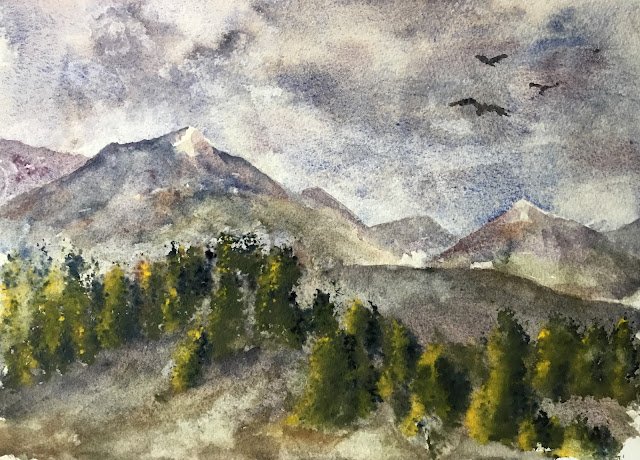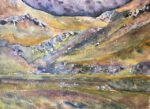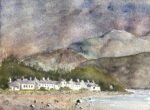As I said in the last post, I felt like I could do a second…

Hills In Tundra Colours
The rain’s finally stopped, so I’m back on the watercolours at last. I thought I’d let myself back in gently by painting an imaginary landscape and by giving the tundra supergranulators a runout. No pressure, just all the fun of painting. As well as the five supergranulating tundra colours, I’ve used cadmium yellow. More on that later.
I started off with a sky of tundra blue, tundra violet and tundra pink. It’s just impossible to go wrong with those colours. I thoroughly wet the sky area first then dropped in the three colours wherever I fancied, with the board tipped up. I tipped the board up and let the colours run, stepping in to mop up puddles with a dry brush and dabbing out the odd white area with kitchen paper.
Then I added the mountains, using whatever colour I fancied everywhere. This is where I noticed the tundra green and tundra orange actually blending nicely into the other three colours. Up to now I was resigned to mainly using them for things like buildings but, no, they’re proper landscape colours.
Before adding the foreground hill, I tried painting some buildings along the top on the left of the painting using paint straight from the tube and a palette knife and later a credit card. I’d seen Steve Mitchell (The Mind Of Watercolour) do something similar on YouTube, then spray the building shapes and, when the paint started running down, sweep the dribbles across the foreground. It didn’t work for me, though. I couldn’t get the right shapes on the paper. So I decided to cover up the resulting problem area with trees.
I know from prior experience that I can’t just add foreground trees with these tundra paints and that I need help from outside the palette. So, while the trees were initially stabbed in with dry tundra green paint on a Merlin brush, I also needed to stab in some cadmium yellow down the left sides of the trees and some shadowy tundra blue down the right sides. I also wet the bottom of the trees and brushed them into the closest foreground area to keep everything connected together.
Then I added the birds as a finishing touch.
I rate this painting as a success and it’s going up for sale. To see the price, click here. The sky’s moody and there are interesting colours in the mountains and interesting textures in the foreground. Perhaps most importantly, I’m starting to understand how to make these colours granulate.
This painting came out pretty quickly. I don’t know whether this was because I had one eye on the dark clouds in the North or because I was so excited to be back on the watercolours or because imaginary landscapes are quicker than real ones but it was one of my faster ones. I felt like I had more in the tank and could do another quick painting.
To be continued in the next post.








Leave a Reply